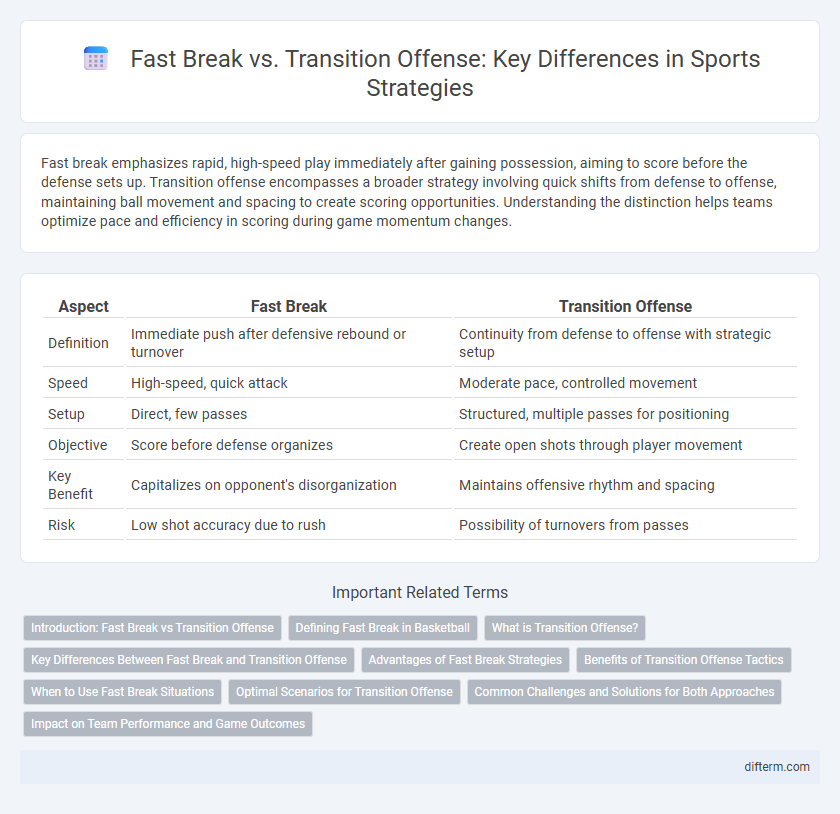Fast break emphasizes rapid, high-speed play immediately after gaining possession, aiming to score before the defense sets up. Transition offense encompasses a broader strategy involving quick shifts from defense to offense, maintaining ball movement and spacing to create scoring opportunities. Understanding the distinction helps teams optimize pace and efficiency in scoring during game momentum changes.
Table of Comparison
| Aspect | Fast Break | Transition Offense |
|---|---|---|
| Definition | Immediate push after defensive rebound or turnover | Continuity from defense to offense with strategic setup |
| Speed | High-speed, quick attack | Moderate pace, controlled movement |
| Setup | Direct, few passes | Structured, multiple passes for positioning |
| Objective | Score before defense organizes | Create open shots through player movement |
| Key Benefit | Capitalizes on opponent's disorganization | Maintains offensive rhythm and spacing |
| Risk | Low shot accuracy due to rush | Possibility of turnovers from passes |
Introduction: Fast Break vs Transition Offense
Fast break and transition offense are critical components in basketball that emphasize speed and quick decision-making to capitalize on scoring opportunities. The fast break is a sudden, aggressive push toward the basket immediately after a defensive rebound or turnover, aiming to outpace the defense. Transition offense encompasses a broader strategy that balances rapid scoring with organized movement, ensuring efficient spacing and passing during the shift from defense to offense.
Defining Fast Break in Basketball
Fast break in basketball refers to an aggressive offensive strategy where a team pushes the ball quickly upcourt after gaining possession, aiming to score before the defense can set up. This technique capitalizes on speed, spacing, and quick decision-making to create high-percentage scoring opportunities. Fast breaks often result in layups or open shots, enhancing scoring efficiency during moments of defensive disarray.
What is Transition Offense?
Transition offense in basketball refers to the strategic phase where a team quickly moves the ball from defense to offense after gaining possession, aiming to score before the opposing defense is fully set. This offensive approach emphasizes speed, swift decision-making, and exploiting numerical advantages to create high-percentage scoring opportunities. Unlike a fast break, which is an immediate push to score in a few seconds, transition offense can include both quick attacks and more controlled advances, adapting to the defensive setup.
Key Differences Between Fast Break and Transition Offense
Fast break emphasizes quick, aggressive scoring attempts immediately after a defensive rebound or turnover, relying on speed and numbers advantage before the opposing defense can set up. Transition offense involves a more structured approach to moving the ball upcourt, balancing speed with maintaining spacing and positioning to exploit defensive mismatches. Key differences include the level of urgency, decision-making speed, and emphasis on player roles during the offensive push.
Advantages of Fast Break Strategies
Fast break strategies in basketball capitalize on rapidly advancing the ball before the opposing defense can set up, creating high-percentage scoring opportunities. This approach increases offensive efficiency by exploiting numerical advantages and forcing defenders into mismatches or hurried decisions. By maintaining a quick tempo, teams can control game momentum and wear down opponents physically and mentally.
Benefits of Transition Offense Tactics
Transition offense tactics in basketball enable teams to capitalize on defensive rebounds and turnovers, creating high-percentage scoring opportunities before the opposing defense is set. Quick ball movement and strategic spacing increase scoring efficiency by stretching defenses and exploiting mismatches during the transition phase. These tactics enhance overall team momentum, promote fast scoring bursts, and improve offensive rhythm throughout the game.
When to Use Fast Break Situations
Fast break situations are most effective immediately after a defensive rebound or turnover, exploiting the opponent's unsettled defense for quick scoring opportunities. Utilizing fast breaks is ideal when your team has superior speed and ball-handling skills to outpace defenders before they set up. This strategy maximizes scoring efficiency by capitalizing on numerical advantages and creating open shots in the paint or on the perimeter.
Optimal Scenarios for Transition Offense
Transition offense is most effective when a team secures a defensive rebound or forces a turnover, allowing for rapid movement upcourt before the opposing defense is set. Players with high speed and court vision capitalize on numerical advantages by creating open lanes and quick scoring opportunities. Optimal scenarios include fast breaks initiated from rebounds or steals, especially when key playmakers exploit spacing and timing to overwhelm opponents.
Common Challenges and Solutions for Both Approaches
Fast break and transition offense often face challenges such as maintaining player spacing, ensuring quick decision-making, and managing defensive pressure effectively. Solutions include emphasizing precise communication, practicing situational drills to enhance players' anticipation, and fostering team chemistry to improve off-ball movement. Both approaches benefit from a balance of speed and control to exploit scoring opportunities while minimizing turnovers.
Impact on Team Performance and Game Outcomes
Fast break strategies accelerate scoring opportunities by exploiting defensive mismatches, significantly increasing a team's points per possession and pace of play. Transition offense emphasizes organized movement and spatial positioning, enhancing ball control and reducing turnovers, which leads to sustained scoring runs and game momentum. Teams adept in both fast break and transition offense demonstrate higher efficiency ratings and improved win-loss records due to diversified offensive options and adaptive gameplay.
fast break vs transition offense Infographic

 difterm.com
difterm.com